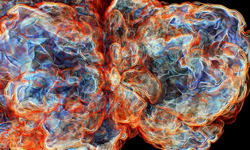 Explore sessions covering topics ranging across domain-specific use cases, to the fundamentals of how GPU computing works and what’s new in the latest developer tools.
Explore sessions covering topics ranging across domain-specific use cases, to the fundamentals of how GPU computing works and what’s new in the latest developer tools.
From weather forecasting and energy exploration, to computational chemistry and molecular dynamics, NVIDIA compute and networking technologies are optimizing nearly 2,000 applications across a broad-range of scientific domains and industries. By leveraging GPU-powered parallel processing, users can accelerate advanced, large-scale applications efficiently and reliably, paving the way to scientific discovery.
Explore sessions across a variety of topics ranging across domain-specific use cases, to the fundamentals of how GPU computing works and what’s new in the latest developer tools.

- Convergence of AI and HPC to Solve Grand Challenge Science Problems
The response to the COVID-19 pandemic poses a Grand Challenge Science problem with immediate impact for global health and well-being. We’ll discuss the award-winning work that was recognized at the recent SC20 event with the Gordon Bell for COVID competition, and provide insight into how the methods were applied, and their future plans.
Tom Gibbs, Manager, Developer Relations, NVIDIA
Rommie Amaro, Professor, UCSD
Arvind Ramanathan, Professor, ANL
James Phillips, Senior Research Programmer, University of Illinois
Lillian Chong, Associate Professor, University of Pittsburgh
Thomas Miller, CEO, Entos
- Mixed-Precision Machine Learning Method for Environmental Applications on GPUs
A primary machine learning algorithm for spatial statistics is the maximum log-likelihood estimation (MLE) function, whose central data structure is a dense covariance matrix that requires two operations: inverse and determinant evaluation. To reduce the time complexity, we migrate MLE to three-precision approximation (double/single/half) by exploiting the loss of correlation with distance. We exploit the advantages of NVIDIA Tensor Core technology to accelerate spatial modeling on large-scale soil moisture and wind speed real datasets.
Hatem Ltaief, Principal Research Scientist, KAUST
Sameh Abdulah, Research Scientist, KAUST
- Introducing Developer Tools for Arm and NVIDIA Systems
Explore the role of key tools and toolchains on Arm servers, from Arm, NVIDIA and elsewhere — and show how each tool fits in the end-to-end journey to production science and simulation.
David Lecomber, Senior Director, Arm
- Physics-Guided Deep Learning for Fluid Dynamics
This talk will demonstrate the advantages of using a Turbulent-Flow Net and Equivariant Net approach to a variety of physical systems including fluid and traffic dynamics.
Rose Yu, Assistant Professor, University of California, San Diego
- How GPU Computing Works
Come for an introduction to GPU computing by the lead architect of CUDA. We’ll walk through the internals of how the GPU works and why CUDA is the way that it is, and connect the dots between physical hardware and parallel computing.
Stephen Jones, CUDA Architect, NVIDIA
Register today for free and start building your schedule.You can also explore featured HPC sessions here and GPU programming sessions here.
